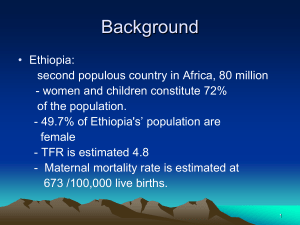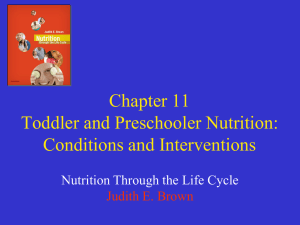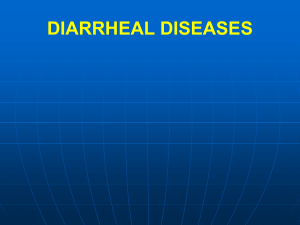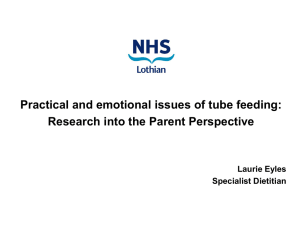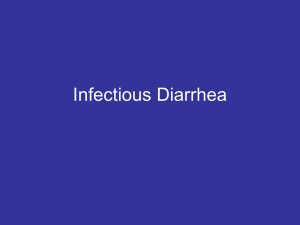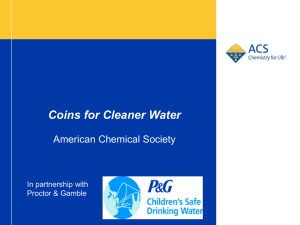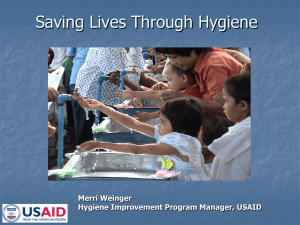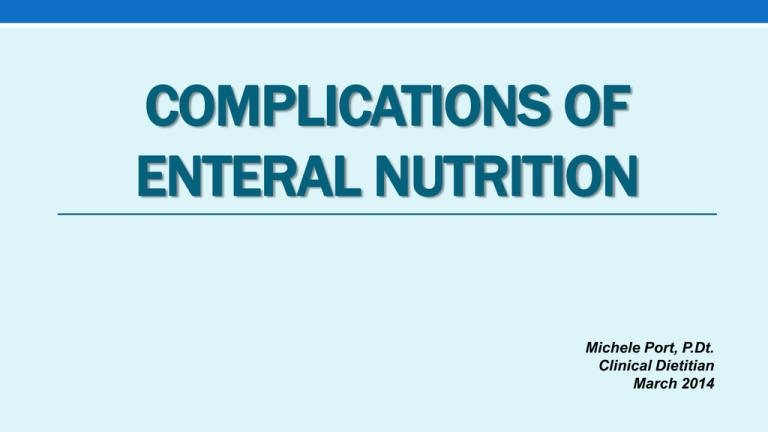
COMPLICATIONS OF
ENTERAL NUTRITION
Michele Port, P.Dt.
Clinical Dietitian
March 2014
Outline
★
Gastrointestinal Complications:
○ Diarrhea
○ Constipation
○ Delayed gastric emptying
○ Nausea and vomiting
○ Abdominal distention
★
Metabolic Complications
★
Administrative Complications
★
Case Study
★
Conclusion
Learning Objectives
★
Recognize various complications of enteral feeding and how to prevent and
treat them.
★
Identify medications which often play a role in the diarrhea and constipation
of enterally fed patients.
Gastrointestinal Complications
DIARRHEA
★
★
Incidence in tube fed patients: 2-63% of tube fed patients depends on definition
★
Common GI side effect in tube fed patient
★
Tube feeding formula usually blamed
★
Impact of diarrhea:
○ Fluid, electrolyte and acid-base disturbances
○ Inadequate nutrient intake which leads to malnutrition
○ Trace mineral deficiencies (Se, Zn)
○ Contamination of pressure ulcers and excoriation skin
○ Increases cost (Need rectal tube, cultures and linen changes)
Gastrointestinal Complications
DIARRHEA
★
★
Universal definition does not exist:
○ > 3 stools per day for 2 consecutive days OR > 500 mL stool every 8hr
Mobarhan et al. 1995; Williams et al. 1998
○ > 200g stool per day OR ≥ 3 or more liquid stools per day
Bliss et al. 1992
o Studies on diarrhea in tube fed patients use different definitions
o Clinically useful definition: Abnormal volume or stool consistency for an
individual
Gastrointestinal Complications
DIARRHEA
★
What is patient’s normal stool consistency and frequency at home?
★
Measurement of stool volume
○ Using pad or bed pan under patient, weight of stool lg / mL stool
○ Rectal tube or fecal management device where stool can be quantified
Boullata et al. , eds. 2010
Gastrointestinal Complications
DIARRHEA
★
★
Osmotic Diarrhea
○ Caused by osmotically active substances in intestines
○ The osmotic force pulls fluid into the intestinal lumen
○ Examples: Lactulose, sorbitol, magnesium, phosphate, hyperosmolar
enteral formula
★
Secretory Diarrhea
○ Imbalance between absorption and secretion of electrolytes with a net
water secretion in bowel lumen
○ Examples: C. difficile infection, enteroviruses, laxatives such as senna,
colchicine
Btaiche et al. 2010
Gastrointestinal Complications
DIARRHEA
★
★
Common Causes:
○ Medication
■ Antibiotic therapy
■ Hyperosmolar medications
■ Sorbitol: containing medications
■ Other (ex.: colchicine)
○ Infection
■ C. difficile
■ CMV: cytomegalovirus in post transplant or immunosuppressed pts
Gastrointestinal Complications
DIARRHEA
★
★
Common Causes:
○ Enteral formula contamination
○ Maldigestion or malabsorption
■
Steatorrhea
○ Bacterial overgrowth
○ Overflow diarrhea
○ Lactose intolerance
○ Severe hypoalbuminemia
Gastrointestinal Complications
DIARRHEA
★
★
Common causes medication-induced:
○ Antibiotic therapy
■
Non-infectious
●
■
Commonly cause diarrhea without causing CDAD
(C. difficile associated diarrhea)
Infectious
●
C. difficile associated diarrhea (Ex.: Clindamycin, Ampicillin)
○ Oral electrolyte supplements (Ex.: Magnesium)
Gastrointestinal Complications
DIARRHEA
★
Common causes medication-induced:
○ Laxatives
■
Lactulose: Osmotic type diarrhea
■
Senna:
Secretory type diarrhea
○ Prokinetics (Ex.: Maxeran, Erythromycin)
○ Hyperosmolar medications
(Ex.: Liquid multivitamins, nystatin suspension, docusate syrup, kayexalate)
■
Can cause osmotic diarrhea, nausea, abdominal cramping if
undiluted on administration via SB
●
Ex.: Cimetidine solution (Tagamet), furosemide (Lasix), doxycycline
(Vibramycin), hydroxyzine (Vistaril), isoniazid, nortriptyline
Gastrointestinal Complications
DIARRHEA
★
Common causes medication-induced:
○ Sorbitol: Containing medications
■
Sorbitol: a sugar alcohol used as a sweetener in oral medications
■
May cause osmotic diarrhea and abdominal cramps or bloating
■
Inactive ingredient in liquid medications, amounts often not listed on
label or package insert
○ Acid-suppressive medications (Ex.: Proton-pump inhibitor )
○ Chemotherapeutic drugs
○ Other: colchicine
Boullata J et al. 2010, Btaiche IF, et al. 2010, Malone A, et al. 2007
Gastrointestinal Complications
DIARRHEA
★
Common causes:
○ Infection
■ Need stool assay to rule out C. difficile associated diarrhea
■ Enteroviruses: Rotavirus, norwalk
■ CMV colitis in immunosuppressed
○ Contamination of enteral feeding solution
■ Needs to ensure gloves are clean when handling enteral spike sets/
tubing for open tube feeding formulas
■ All equipment to prepare enteral feeding must be clean
■ Open tube feeding formula needs to be refrigerated and formula
discarded after 24hr. Label with date and time opened
Gastrointestinal Complications
DIARRHEA
★
Common causes:
○ Contamination of enteral feeding solution
■
Only 4hr of feeding should be hung at one time for open feeding
systems
■
Feeding bags and tubing should be washed after each intermittent
feeding and discarded after 24hr
■
Closed feeding systems need to be labelled with date and time when
bag spiked and discarded after 48hr
Gastrointestinal Complications
DIARRHEA
★
Common causes:
○ Maldigestion / Malabsorption
■
■
Definition
•
Maldigestion: Impaired breakdown at nutrients
•
Malabsorption: Defective mucosal uptake and absorption
from bowel
Diarrhea, weight loss, steatorrhea (fat malabsorption)
Gastrointestinal Complications
DIARRHEA
★
Common causes:
○ Maldigestion / Malabsorption
■
Celiac disease
■
Short bowel syndrome
■
Resection of terminal ileum
■
Human immunodeficiency virus
■
Pancreatic insufficiency
■
Inflammatory bowel disease
■
Protein-losing gastroenteropathies
■
GVHD of gut
Gastrointestinal Complications
DIARRHEA
★
Common causes:
○ Maldigestion / Malabsorption
■ Past medical history part of nutrition assessment
•
When interviewing patient / family ask regarding usual bowel habits
•
Medications which affect bowel movements. Lactulose, Imodium,
herbal teas
■ Tests
•
Look at stool - fat floating on top?
•
Steatocrit to assess fecal fat content
•
Check B12, folate, vitamin A level
Malone et al. 2007
Gastrointestinal Complications
DIARRHEA
★
Common causes:
○ Bacterial overgrowth
■ Diagnosed by distal duodenal or jejunal aspirates, high serum folate
(de novo synthesis) or hydrogen-methane breath tests
■ Chronic diarrhea with minimal steatorrhea
■ Associated with achlorhydria, bile acid deficiency, dysmotility (pseudo
obstruction, diabetic neuropathy, narcotics)
○ Overflow diarrhea
■ Occurs in chronic-care immobilized patients
■ Liquid flowing around hard feces
■ Volume of stool not large usually
Gastrointestinal Complications
DIARRHEA
★
Common causes:
○ Lactose intolerance
■ Majority of commercial tube feeding formulas are lactose free
■ Patient on food and tube feeding may be receiving lactose in diet
○ Severe hypoalbuminemia
■ Decreases oncotic gradient across bowel wall
■ May be due to malnutrition, stress, fluid overload
○ Edematous bowel
■ Patient with anasarca likely has edema of the bowel also
■ Diarrhea often improves with fluid removal such as continuous
dialysis
Gastrointestinal Complications
DIARRHEA
★
Treatment
○ Rule out C. difficile associated diarrhea
○ Medication review with pharmacist
■
Discontinue medications suspected of causing diarrhea if possible
■
Sorbitol-containing oral liquid medications should be discontinued and
replaced with tablets
■
Mg or K-elixir given via tube should be given IV to see if it makes a
difference
■
Review antibiotic use
■
Dilute drugs introduced into jejunum to avoid dumping-like syndrome
Btaiche IF, et al. 2010
Gastrointestinal Complications
DIARRHEA
★
Treatment
○ Review medical / surgical history
■ Is patient with pancreatic insufficiency on a high fat formula
(ex.: renal formula) without pancreatic enzymes?
■ Use a lower fat formula or a formula with 50%-70% of fat as MCT
■ Steatorrhea
• Use lower fat formula
■ Severe GVHD of gut: consider parenteral nutrition until diarrhea
decreases, use trophic feeding at low rate if tolerated
■ Extensive SB resection
• Trial of elemental formula (low fat) or semi-elemental formula
(protein in peptides, at least 50% fat in form of MCT)
Gastrointestinal Complications
DIARRHEA
★
Treatment
○ Review medical / surgical history
■
Irritable bowel syndrome (IBS)
•
High fructose corn syrup, fructooligosaccharides (FOS),
galactooligosaccharides and inulin can cause diarrhea, pain and
bloating in IBS patients
Barrett, et al. 2009
Gastrointestinal Complications
DIARRHEA
★
Treatment
○ Enteral Formula
■
Trial of formula with fibre
■
In ICU patients: use soluble fibre but only when hemodynamically
stable and fully resuscitated
■
Soluble fibre is fermented to SCFA
■
SCFA are absorbed in the colon pulling water and electrolytes with
them
McClave et al. 2009; Btaiche, et al. 2010
Gastrointestinal Complications
DIARRHEA
★
Treatment
○ If feeding with a hypertonic formula consider trial with an isotonic formula
○ Decrease rate temporarily
○ Avoid intermittent feeds
Gastrointestinal Complications
DIARRHEA
★
Treatment
○ Fiber supplements may help
■ Pectin (Certo): for diarrhea every 4-8 hr
●
Mix 30mL pectin with 100 mL warm water, syringe into feeding
tube and flush well with 60mL water
■ Benefiber (Novartis) (Inulin)
●
Rounded 1 tsp (312g) provides 3g fibre, mix 1-2 tsp benefiber
with ½ cup (125mL) water
■ Clearly fibre (Inulin)
●
3.2g sachet provides 3g fibre
Gastrointestinal Complications
DIARRHEA
★
Treatment
○ Antimotility agents (loperamide, lomotil)
■ Loperamide: lower risk of central nervous system adverse effects
■ Slows intestinal motility
■ Contraindicated in C. difficile diarrhea and may aggravate toxic
megacolon
■ Use only when all other causes of diarrhea have been addressed
○ Cholestyramine
■ An insoluble ion exchange resin that binds bile acids in intestines
■ May be beneficial in diarrhea due to bile acid malabsorption,
Ex.: cholestasis, short bowel syndrome, terminal ileum resection
Gastrointestinal Complications
DIARRHEA
★
Treatment
○ Fluid and electrolyte replacement to replace GI losses
○ Chronic diarrhea can lead to micronutrient deficiencies especially
selenium and zinc, may require supplements
Gastrointestinal Complications
CONSTIPATION
Clinical definition: accumulation of excess waste in colon
★ Can identify this with abdominal X-ray, able to rule out ileus or obstruction
★ Causes of constipation
○ Immobility
○ Neurological disorders
○ Dehydration
○ Inadequate fibre in enteral nutrition
○ Excessive fibre in enteral nutrition
○ Some medications (Ex.: sedatives, analgesics, opioids) gut motility
○ Acute colonic pseudo obstruction (Ex.: Ogilvie’s syndrome)
○ GI motility disorders
★
Gastrointestinal Complications
CONSTIPATION
★
Consequences
○ Delayed transit time
○ Vomiting
○ Abdo. distension
○ Risk of perforation
○ Bacterial overgrowth
○ Prolonged ventilator dependence in ICU patients
★
Electrolyte disturbances
○ Severe hypokalemia and hypomagnesemia may result in bowel motility
○ Severe hypokalemia may result in paralytic ileus
Gastrointestinal Complications
CONSTIPATION
★
Treatment and Prevention
○ Use a bowel regimen when you start enteral feedings
○ Calculate the fluid requirement for a patient that is on enteral feeding:
■
30-40 mL/kg OR 1 mL/Kcal (minimum for adults)
○ Use fibre-containing enteral feeding with adequate fluid.
Avoid formula with fibre if fluid restricted
○ Medication review: Medication-induced dysmotility?
Gastrointestinal Complications
CONSTIPATION
★
Treatment and Prevention
○ Laxatives
■ Emollients (Ex.: Sodium docusate)
• Maintain soft fecal texture
• Onset of action: 1-3 days
• Not likely beneficial after stools harden
■ Osmotics (Ex.: Lactulose)
• Non absorbable sugar
• Onset of action: 1-3 days
■ Stimulants (Ex.: Senna, bisacodyl)
•
Increase lower GI motility and anal sphincter tone
•
Onset of action: 6-12 hr after oral dose
Gastrointestinal Complications
CAUSES OF DELAYED GASTRIC EMPTYING
★
Causes of delayed gastric emptying
○
○
○
○
○
○
○
○
○
Hypotension
Hypokalemia
Sepsis
Medication(anesthesia, opioids, anti-cholinergics)
Diabetes mellitus (gastroparesis)
Rapid infusion of formula or cold formula
Formula infusion
High fat feeding formula
Hyperglycemia
Gastrointestinal Complications
CAUSES OF DELAYED GASTRIC EMPTYING
★
Treatment
○ Duodenal or jejunal feeding
○ Prokinetic agents (Ex.: Maxeran, erythromycin)
○ Low fat feeding formula
○ Check residual volume every 4hr and assess tolerance
■
Follow feeding algorithm
Gastrointestinal Complications
NAUSEA and VOMITING
★
Nausea may be caused by high enteral feeding rate or volume or medications
○ Treat with antiemetics
○ Decrease rate or volume
○ Review medications
★
Vomiting may be caused by GI obstructions, medications, delayed gastric
emptying
○ Hold enteral nutrition if GI obstruction
○ Use antiemetics
○ Hold feeds x 1hr then reassess
Gastrointestinal Complications
ABDOMINAL DISTENTION
★
Abdominal Distention
○ Causes
■ GI ileus
■ Obstruction
■ Obstipation
■ Ascites
■ Lactose intolerance
■ Rapid infusion of enteral formula
■ Infusion of cold formula
○ Rule out ileus or obstruction, do abdominal Xray
Metabolic Complications
Problem
Possible Causes
Overhydration
●
●
Prevention / Treatment
Excessive fluid intake
Heart Failure, renal failure
●
●
●
●
●
Dehydration
●
●
●
●
●
●
Excessive fluid loss:
Vomiting, Diarrhea, Ileostomy output
Inadequate fluid intake
Hypertonic fluid intake
Hypertonic feeding formula
High protein feeding formula
Hyperglycemia
●
●
●
●
●
●
Limit fluid intake
Use calorie dense formula
Use diuretic if appropriate
Monitor intake and output (I/O)
Weight patient
Monitor I/O
Check skin turgor
Monitor wt
Monitor urea: Cr (normal 1:10)
Increase enteral fluid flush
Use less concentrated formula
Boulatta et al, eds 2010, Malone et al. 2007, St-Laurent 2009
Metabolic Complications
Problem
Possible Causes
Hyponatremia
●
●
●
Prevention / Treatment
Dilution, ADH levels
Hepatic, renal or cardiac failure
Excessive losses
●
●
●
●
●
Hypernatremia
●
●
Dehydration
Increased Na intake
●
●
●
Hypokalemia
●
●
●
Refeeding syndrome
Excess losses
Use of diuretics (Ex.: Lasix)
●
●
●
Monitor Na level
Assess fluid status
Limit fluid intake
Na depletion, add Na
Diuretic, if appropriate
Monitor I/O
Provide adequate fluid
Reassess IV fluid
Monitor serum K+
Replete K+ before starting enteral
feedings
Use a K+ supplement
Boulatta et al, eds 2010, Malone et al. 2007, St-Laurent 2009
Metabolic Complications
Problem
Possible Causes
Hyperkalemia
●
Excessive K+ intake
●
Remove K+ form IV
●
Renal Failure
●
Use kayexalate
●
Use of spironolactone
●
Use low K+ TF formula
●
Metabolic acidosis
●
Correct acidosis
●
Refeeding syndrome
●
●
Binding by drugs (epinephrine,
phosphate binders, insulin)
Replete phosphorus before
starting TF
●
Monitor phosphorus
●
Reassess drugs
Hypophosphatemia
Hypomagnesemia
Prevention / Treatment
●
Refeeding syndrome
●
Monitor Mg
●
Increased losses (diarrhea)
●
●
Drugs (Ex.: Cyclosporine)
Supplement Mg before starting
feeding if possible
Boulatta et al, eds 2010, Malone et al. 2007, St-Laurent 2009
Metabolic Complications
Problem
Possible Causes
Hypoglycemia
●
Hyperglycemia
Prevention / Treatment
Sudden cessation of TF in a
patient on insulin therapy
without adjustment of insulin
●
Severe liver failure
●
Diabetes
Steroid therapy
Stress, sepsis
Pancreatic insufficiency
Insulin resistance
●
●
●
●
●
Use an insulin protocol
●
Use D10W IV until TF provides
adequate carbohydrate
●
Adequate insulin
Low carbohydrate formula
Correct serum glucose before
feeding
●
●
Boulatta et al, eds 2010, Malone et al. 2007, St-Laurent 2009
Metabolic Complications
Problem
Possible Causes
Vitamin deficiencies
Vitamin A, D, E, K
●
Vitamin deficiencies
Vitamin D
●
Vitamin deficiencies
Zn, Se
●
●
●
Prevention / Treatment
Fat malabsorption
Pancreatic insufficiency
●
●
Use water soluble supplement
Use pancreatic enzymes
Lack of sunlight
Inadequate vitamin D in
enteral formula
●
Vitamin D supplement
Excessive losses in diarrhea,
ostomy, wound
●
Supplement Zn,Se
Boulatta et al, eds 2010, Malone et al. 2007, St-Laurent 2009
Refeeding Syndrome
★
★
★
★
★
Occurs when severely malnourished patients are refed
Acute intracellular shifts of electrolytes as cell anabolism is stimulated
Results in decreased circulating levels of K+, Mg, phos
Can cause hematologic, neuromuscular, cardiac and respiratory dysfunction
Prevention / Treatment:
○ Identify patients at risk
○ Correct electrolytes before starting EN
○ For the first day limit energy provided to 25% of requirements and
progress gradually over 3-5 days to 100% of energy requirement
○ Supplement with thiamine 100mg/day X 3-5 days
○ Monitor for signs of fluid retention
○ Monitor electrolytes daily until at mantenenace and replete low levels
Administrative Complications
ASPIRATION
Tube feeding, gastric secretions, or oral secretion enter the lungs
★ A severe complication of enteral feeding
★ Risk factors
○ supine position
○ regurgitation
○ vomiting
○ delayed gastric emptying
○ decreased level of consciousness
○ patient pulling out nasoduodenal tube while feeding is running
○ poor oral hygiene
○ mechanical ventilation
○ neurological disease
★
Administrative Complications
ASPIRATION
Progression from aspiration of tube feeding formula to pneumonia depends on
the amount, acidity of formula, and the microbial content and the health of the
patient
★ To decrease aspiration risk
○ HoB 30-45o if not contraindicated
○ Small bowel feeding tubes
○ Motility agents
■ Ex.: Metoclopramide: ineffective in head-injured patients, Erythromycin
○ Oral Hygiene
■ Chlorhexidine mouthwash should be used twice daily to VAP risk in
mechanically ventilated patients
★
Case Study
66 year old male, post liver transplant 2009 with recurrent HCV on liver bx
admitted to hospital due to cholangitis due to stones and needs surgery to
remove one of the stones. Transferred to ICU with respiratory failure,
anasarca, hyponatremia, hyperkalemia, C. difficile diarrhea and AKI with
anuria and Cr.
Intubated, ventilated, bronchoscopy performed. Found gastric fluid in lungs,
vocal cords which didn’t close. Aspiration pneumonia diagnosed.
Continuous veno-venous hemodialysis will be started. The patient had a PEG
inserted 2 weeks before ICU admission due to inadequate food intake.
(He had pulled out 3-4 nasoduodenal tubes)
He was also eating some food. (200-300Kcal per day)
Case Study
Case
Study
➔ Abdomen:
◆
Non-tender
◆
CT scan of abdo: nothing acute
◆
Diarrhea but not copious amounts
➔ GU:
◆
High potassium treated with kayexalate
◆
On CVVHDF, urea, Cr, K, phos decreasing
◆
Still anasarca
Case Study
Problems:
➔ Aspiration:
◆ Gastric contents seen on bronchoscopy
◆ Vocal cords not closing
➔ Diarrhea
◆ C. Difficile
➔ Electrolyte abnormalities
◆ Acute kidney injury (AKI)
◆ Likely not related to tube feeds
➔ Overhydration
◆ Treated with continous dialysis
Case Study
Should you use PEG for feeding?
Case Study
➔ Decision at morning rounds to use PEG until PEG/J can be arranged
through radiology
◆
Promotility drug initially (despite diarrhea)
◆
Check residuals every 4hr
Case Study
Which formula?
• On continuous dialysis with DNFL 100
• If anasarca likely has gut edema and may have decreased absorption
• History of C. difficile diarrhea diagnosed and treated X 5 days
Case Study
➔ Vivonex plus and protein powder
◆
Elemental: easier to absorb
◆
Low fat
Case Study
➔ Estimated calorie requirement:
Ht = 170 cm
Tmax = 36.9 0 C
Wt = 66.5 kg
Ve = 9:44
➔ Mifflin St. Jeor: REE Kcal / day
Male:
10 (wt) + 6.25 (ht) - S (age) + 5
Female: 10 (wt) + 6.25 (ht) - S (age) - 161
➔ Mifflin St. Jeor:
10 (66.5) + 6.25 (170) - 5 (66) + 5 = 1402
➔ Penn state(mifflin) =
Mifflin (.96) + Tmax (167) + Ve (31) - 6212 =
1402 (.96) + 26.9 (167) + 9.44 (31) - 6212 = 1589
➔ Estimated protein requirements on CVVHDF: 133 - 166 g (2-2.5 g/kg)
Case
Case Study
Study
➔ Vivonex plus: 1000 Kcal / mL
45 g protein / litre
➔ Beneprotein powder: 6 g protein / scoop
➔ No need to calculate Na, K, phosphorus because pt on CVVH (continuous
dialysis)
Case
Case Study
Study
1200 mL
Vivonex Plus
Beneprotein
Total
Kcal
1200
325
1525
Protein (g)
54 g
78 g (13 scoops)
132 g
➔ Start Vivonex plus slowly at 20 mL/hr and advance by 15 mL/hr
every 8hr to 50 mL/hr with 13 scoops protein powder daily
Case Study
➔ Good tolerance
➔ No residuals
➔ Pasty and loose stools approx 3 times per day
➔ Good glycemic control
➔ Electrolytes monitored
Case
Case Study
Study
➔ 1 week later, PEG/J inserted
➔ Extubated on HHM
➔ Continuous dialysis stopped
➔ U/O: 150-200 mL / 8 hr
Which formula should I use?
Case
Case Study
Study
➔ Formula
◆
◆
Renal formula: high in fat so did not want to use this in patient with
diarrhea
Vivonex plus: 1 Kcal / mL, not calorie dense. Need to limit fluid
volume
◆
No hemodialysis at present time
◆
Used semi-elemental formula 1.5 Kcal / mL
◆
◆
Able to keep protein in recommended range, potassium less than
60 mmol, phosphorus a little high at 1350 mg, fluid approximately
1200 mL
Monitor: electrolytes, diarrhea
Case Study
Can this patient eat?
Case
Case Study
Study
➔ ENT service says pt has voice so vocal cords not paralyzed
➔ Swallowing assessment by OT
➔ OT will do modified barium swallow
Case
Case Study
Study
➔ Patient stable and transferred to transplant ward.
Conclusion
➔ It is important to be aware of the various complications which can occur with
enteral feeding.
➔ All members of the medical team should monitor the patient to try to prevent
these problems from occurring and should be aware of how to treat them
➔ The gastrointestinal complications often lead to enteral feeding being held
and if feedings are held too often this compromises the nutritional status of
patients.
➔ Often takes trial and error to solve problems with diarrhea and constipation.
References
Barrett JS, Sheperd SJ, Gibson PR. Strategies to manage gastrointestinal symptoms complicating enteral
feeding. JPEN 2009; 33: 21-26.
Bliss DZ et al. Defining and reporting diarrhea in tube-fed patients – what a mess! Am J Clin Nutr. 1992;
55: 753-759.
Boullata J, Nieman Carney L, Guenter P, eds. A.S.P.E.N. Enteral Nutrition handbook.
Silver Spring, MD: American Society for Parenteral and Enteral nutrition; 2010: 267-307.
Btaiche IF, et al. Critical illness, gastrointestinal complications and medical therapy during enteral feeding
in critically ill adult patients. Nutr Clin Pract 2010; 25: 32-49.
Malone A, Serres DS, Lord L. Complications of enteral nutrition. In Gottschlich M, ed. in chief.
The A.S.P.E.N. Nutrition Support Care Curriculum, Silver Spring, MD: American Society for Parenteral and
Enteral Nutrition; 2007: 246-263.
References
McClave SA, Martindale RG, Vanek VW, et al; A.S.P.E.N. Board of Directors; American College of Critical
Care Medicine, Society of Critical Care Medicine. Guidelines for the Provision and Assessment of
Nutrition Support Therapy in the Adult Critically Ill Patient: Society of Critical Care Medicine (SCCM) and
the American Society for Parenteral and Enteral Nutrition (A.S.P.E.N.) JPEN 2009; 33: 277-316.
Mobarhan S, DeMeo M. Diarrhea induced by enteral feeding. Nutr. Rev. 1995; 53: 67-70.
Williams MS, et al. Diarrhea management in enterally fed patients. Nutr Clin Pract. 1998; 13: 225-229.
St-Laurent L. Nutrition entérale: guide practique pour le clinicien. Montréal: McGill University Health
Centre, 2009: 12.1-12.6.

